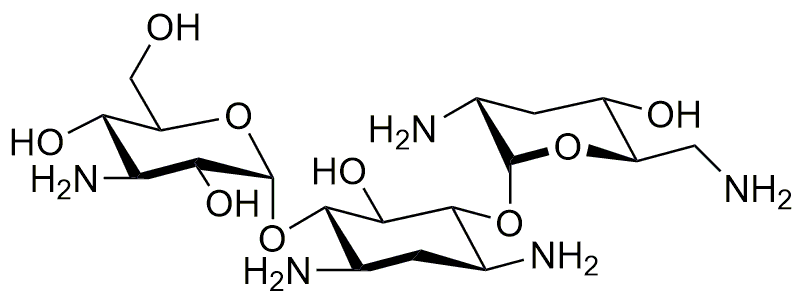Tobramycin is widely utilized in research focused on:
- Antibiotic Treatments: Commonly used to treat serious bacterial infections, particularly in patients with cystic fibrosis, due to its effectiveness against Pseudomonas aeruginosa.
- Inhalation Therapy: Administered via nebulization for respiratory infections, providing targeted delivery directly to the lungs, which enhances efficacy and reduces systemic side effects.
- Ophthalmic Solutions: Formulated in eye drops to treat bacterial infections of the eye, offering a convenient and effective treatment option for conditions like conjunctivitis.
- Research Applications: Employed in laboratory settings to study antibiotic resistance mechanisms, helping researchers develop new strategies to combat resistant strains.
- Combination Therapies: Often used in conjunction with other antibiotics to enhance treatment outcomes for complex infections, allowing for a broader spectrum of activity.
General Information
Properties
Safety and Regulations
Applications
Tobramycin is widely utilized in research focused on:
- Antibiotic Treatments: Commonly used to treat serious bacterial infections, particularly in patients with cystic fibrosis, due to its effectiveness against Pseudomonas aeruginosa.
- Inhalation Therapy: Administered via nebulization for respiratory infections, providing targeted delivery directly to the lungs, which enhances efficacy and reduces systemic side effects.
- Ophthalmic Solutions: Formulated in eye drops to treat bacterial infections of the eye, offering a convenient and effective treatment option for conditions like conjunctivitis.
- Research Applications: Employed in laboratory settings to study antibiotic resistance mechanisms, helping researchers develop new strategies to combat resistant strains.
- Combination Therapies: Often used in conjunction with other antibiotics to enhance treatment outcomes for complex infections, allowing for a broader spectrum of activity.
Documents
Safety Data Sheets (SDS)
The SDS provides comprehensive safety information on handling, storage, and disposal of the product.
Product Specification (PS)
The PS provides a comprehensive breakdown of the product’s properties, including chemical composition, physical state, purity, and storage requirements. It also details acceptable quality ranges and the product's intended applications.
Certificates of Analysis (COA)
Search for Certificates of Analysis (COA) by entering the products Lot Number. Lot and Batch Numbers can be found on a product’s label following the words ‘Lot’ or ‘Batch’.
Numéro de catalogue
Numéro de lot/série
Certificates Of Origin (COO)
This COO confirms the country where the product was manufactured, and also details the materials and components used in it and whether it is derived from natural, synthetic, or other specific sources. This certificate may be required for customs, trade, and regulatory compliance.
Numéro de catalogue
Numéro de lot/série
Safety Data Sheets (SDS)
The SDS provides comprehensive safety information on handling, storage, and disposal of the product.
DownloadProduct Specification (PS)
The PS provides a comprehensive breakdown of the product’s properties, including chemical composition, physical state, purity, and storage requirements. It also details acceptable quality ranges and the product's intended applications.
DownloadCertificates of Analysis (COA)
Search for Certificates of Analysis (COA) by entering the products Lot Number. Lot and Batch Numbers can be found on a product’s label following the words ‘Lot’ or ‘Batch’.
Numéro de catalogue
Numéro de lot/série
Certificates Of Origin (COO)
This COO confirms the country where the product was manufactured, and also details the materials and components used in it and whether it is derived from natural, synthetic, or other specific sources. This certificate may be required for customs, trade, and regulatory compliance.

